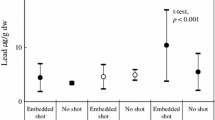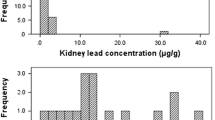Abstract.
Between 1983 and 1986 the National Wildlife Health Center (NWHC) conducted a nationwide study of lead poisoning of waterfowl from federal and state refuges. This survey was done to assist in identifying zones with lead-poisoning problems. One thousand forty one moribund or dead waterfowl were collected and examined. The presence or absence of 13 gross lesions selected as indicators of lead poisoning and three lesions indicating body condition was recorded. Lead-poisoning diagnoses were based on the finding of at least 6–8 ppm (wet weight) lead in the liver and either lead shot in the gizzard content or at least one convincing gross lesion indicative of lead poisoning. Four hundred twenty-one of these waterfowl were diagnosed as lead poisoned. The NWHC survey provided a comprehensive basis for estimating the sensitivities, specificities, and likelihood ratios of the gross lesions of lead poisoning and the associated hepatic lead concentrations for several species of waterfowl. Some of the 13 defined gross lesions were more common than others; frequencies ranged from 3% to 80% in the 421 lead-poisoned waterfowl. The most reliable indicators of lead poisoning were impactions of the upper alimentary tract, submandibular edema, myocardial necrosis, and biliary discoloration of the liver. Each of the 13 lesions occurred more frequently in the lead-poisoned birds, but each of the lesions also occurred in waterfowl that died of other causes. The number of lead shot present in a bird's gizzard was only weakly correlated with its hepatic lead concentration; however, this weak correlation may have been adequate to account for differences in hepatic lead concentrations among species, once the weights of the species were taken into account. Although lead-poisoned ducks tended to have higher hepatic mean lead concentrations than did lead-poisoned geese or swans, the differences were probably a result of a greater dose of shot per body weight than to kinetic differences between species. Hepatic lead concentrations were independent of age and sex. Ninety-five percent of waterfowl diagnosed as lead poisoned had hepatic lead concentrations of at least 38 ppm dry weight (10 ppm wet weight). Fewer than 1% of the waterfowl that died of other causes had a concentration that high. This fifth percentile, of 38 ppm dry weight (10 ppm wet weight), is a defensible criterion for identifying lead-poisoned waterfowl when interpreting hepatic lead concentrations in the absence of pathological observations.
Similar content being viewed by others
Author information
Authors and Affiliations
Additional information
Received: 12 February 1998/Accepted: 22 April 1998
Rights and permissions
About this article
Cite this article
Beyer, W., Franson, J., Locke, L. et al. Retrospective Study of the Diagnostic Criteria in a Lead-Poisoning Survey of Waterfowl. Arch. Environ. Contam. Toxicol. 35, 506–512 (1998). https://doi.org/10.1007/s002449900409
Published:
Issue Date:
DOI: https://doi.org/10.1007/s002449900409




